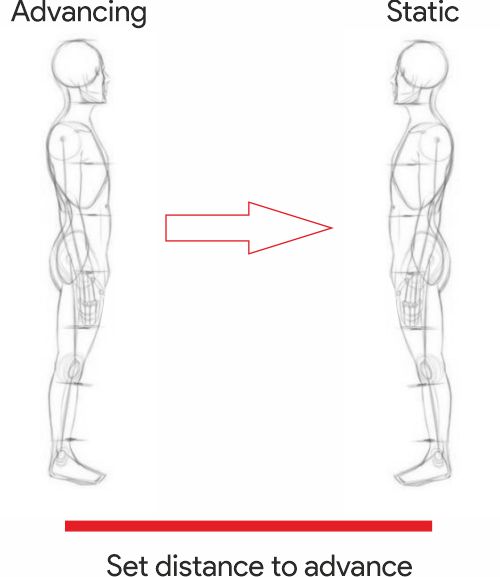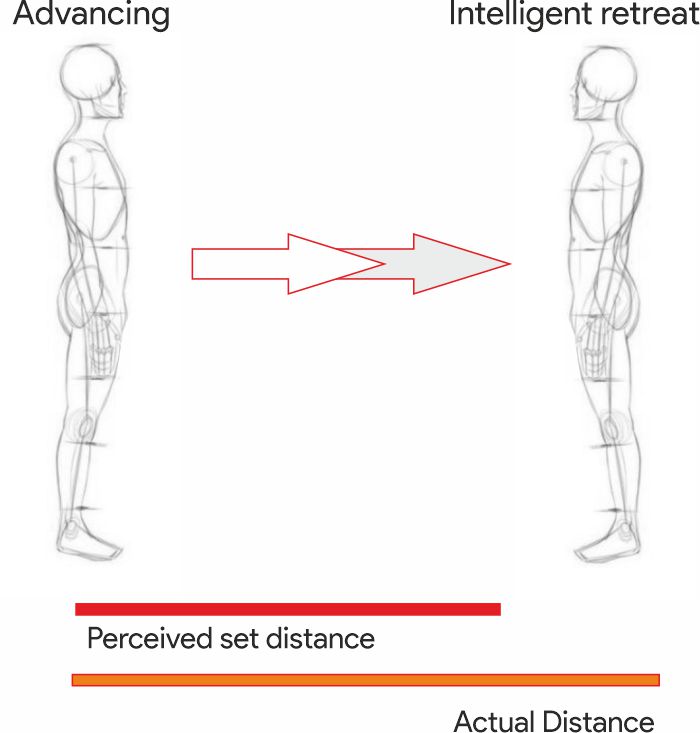In this article we will examine a phrase from the classics that describes a tactic that Tai chi employs to gain its favourable position in combat. It is a nuanced skill and one which links to a number of other qualities that Tai Chi trains, as well as the overarching strategy of the style.
advancing, he finds the distance seems incredibly long;
retreating, the distance seems exasperatingly short.
This is a wonderful phrase from the classic attributed to Wang Tsung-yueh from the 18th century The Treatise on Tai Chi. It describes one of the basic ideas found in Tai Chi combative application, specifically relating to how we manage range and distance. ‘Range management’ is of particular importance in Tai Chi due to its contact and control outlook, and so it is well worth us digging into this subject further.
Advancing, he finds the distance seems incredibly long;
This first part of the verse describes the way in which we can manage an advancing opponent. It asks us to have the quality of always being perceived to be out of grasp of the opponent. This is not to say that we are not in touch, simply that their attempt to gain advantage is unsuccessful in that they are never able to ‘get to us’.
To do this we need to develop superb listening and following skills, two of the primary skills of Tai Chi sensitivity. As the opponent advances on us, we perceive their direction and movement with refined accuracy, and are then able to intelligently retreat in a way that makes them have to travel further than they would otherwise expect.


In the first diagram, we see that advancing on the static individual is a set value and distance. This is easy for an opponent to perceive and factor into their attacking strategy. The static nature of the person may be something that the opponent has set up with initial or preceding movement or distraction tactics but it is fair to say that the static individual is the most vulnerable.
In the second diagram, the previously static individual, intelligently controls the distance between them and the opponent. Here there is the phenomena of stretching the previously set distance. A good analogy is like trying to push open a door as it is opened from the other side at just the same moment. Expectation of the weight of the door is suddenly removed the pusher will stumble through.
This tactic is used in conjunction with leading and guiding the opponents force away from our centre of mass, making the distance seem longer and even more stretched out. At a very basic level it is the concept of retreat from an advance, but at a higher level there is a distinct tactical methodology behind this idea.
The merit of stretching out distance in this way is that it affords opportunity to develop the opponents recovery phase such that they are in it for longer. The longer an opponent spends recovering from their own action, the more time we have to apply our fight ending counter.
An excellent example of this exact idea comes from MMA. In this example the Anderson Silva Knocks out a highly skilled opponent, Forrest Griffin, by over extending him during his attack (the distance seeming incredibly long) and then applying a perfectly timed counter attack in the recovery phase between strikes.

A truly perfect execution of this idea from the classics.
Now of course, we do not need to make this distance change with long or extended footwork. It could very well be that we simply are not there when they try to make contact. Even a small distance can seem like a mile when applied correctly, and this is where the nuance of this idea comes into play.
Retreating, The distance seems exasperatingly short
Of course, the opposite idea is also true. Here a retreating opponent finds that we stay with them, no matter how much they try to escape. This idea is linked to a concept I call ‘clouding’ the opponent. It is like trying to fight a thundercloud you are inside of, everywhere you go, its there! Then suddenly you are struck by lightning!
There is of course the obvious example of clouding an opponent using our footwork advancing on the opponent with our stepping as they try to step away. This is a very obvious example of clouding an opponent, but there is more nuance to this idea then simply to step. As we step, we make small adjustments to angle and position and these adjustments put us on a superior line to make our final attack. It is through this nuance and taking the superior angle on the opponent that we are able to unbalance our opponents equilibrium thus creating the opportunity for decisive action.
But when we move from the macro to the micro, this idea of clouding can be used even when we are static in our feet. Instead of the opponent retreating through stepping, they may retreat through body manipulation; bending and twisting out of the way of incoming forces. The key to staying with the opponent and not allowing them to escape here is found in sensitivity and filling the gaps as they appear. To our opponent we feel as though we are stuck to them in a way that they cannot escape no matter how much they try to wriggle out.
Once again we use angle and positioning to gain advantageous position, create a ‘recovery response’ and ultimately win the encounter.
Final thoughts.
And so these lines from the classics describe in expert detail and clarity some of the most important combative concepts found in Tai chi. Our ability to evade with skill and to fill gaps that appear, so as to cloud an opponent, provide us with a unique tactical advantage. This tactical advantage can be seen in many different martial arts of course, but in Tai chi the added dimensions of sensitivity, listening, joining, following, and adhering make for a unique mix. Once again the classics can point to very real and very practical tactical or strategic considerations in the use of Tai chi.